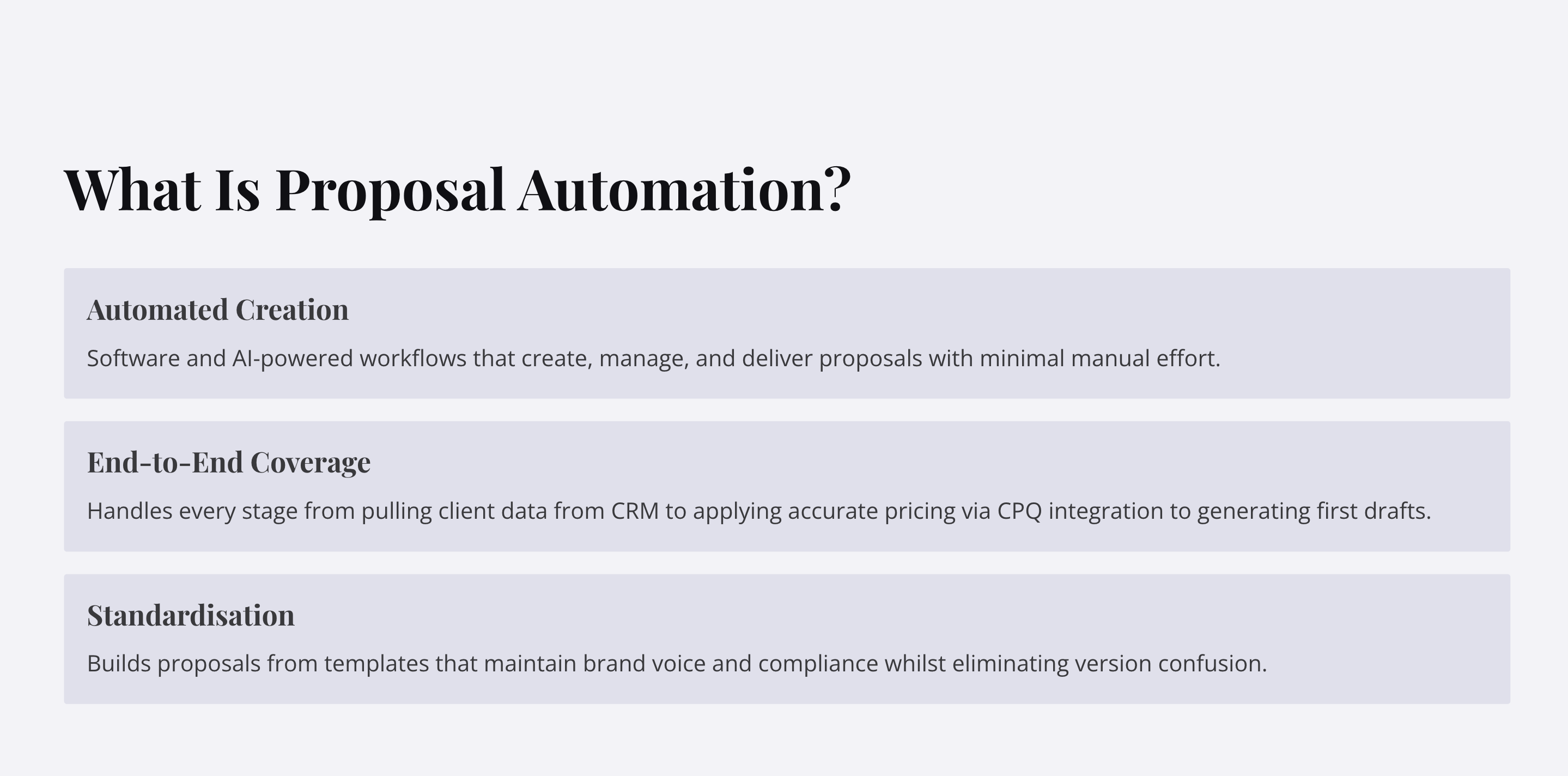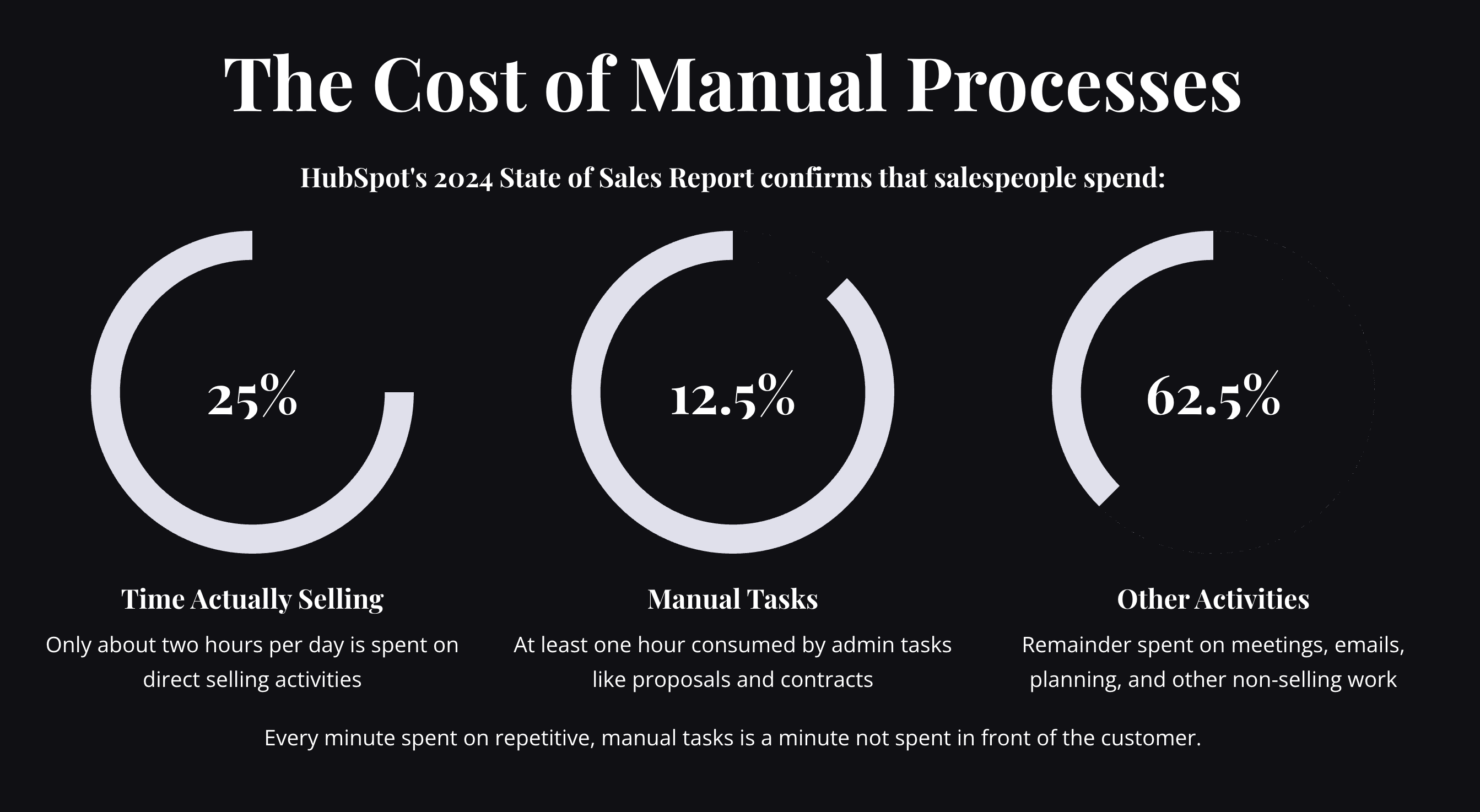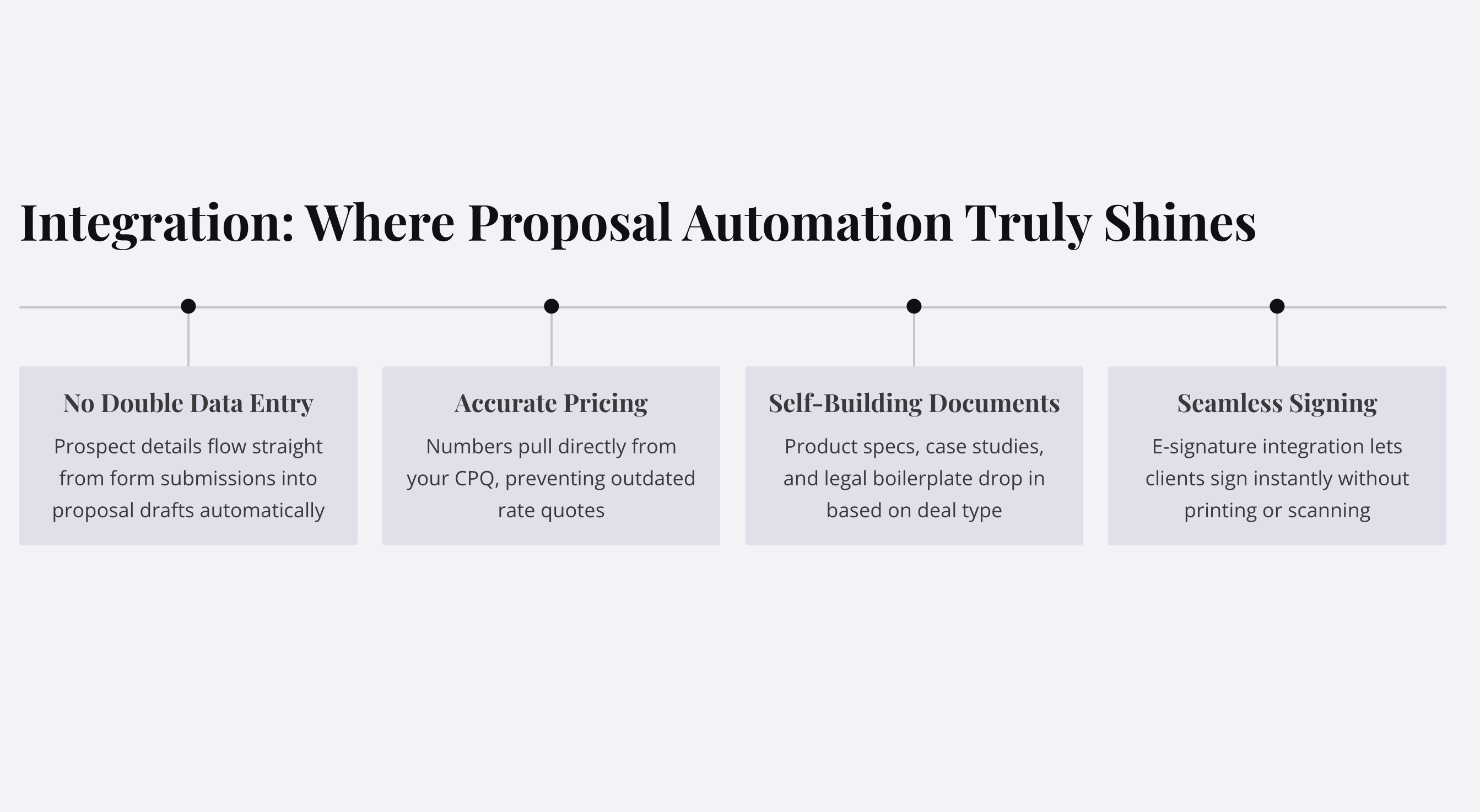What Is Proposal Automation and Why It Matters
Article written by
Kate Williams

INSIDE THE ARTICLE
SHARE THIS ARTICLE
Summary
Proposal automation streamlines the sales process by reducing proposal creation time, increasing bid volume, and improving win rates through integration with CRM, content libraries, and automated workflows. Top teams use AI for first drafts, collaborate in real time, and track analytics to refine strategies and maintain brand consistency.
If you take a look at the competitive sales landscape, speed isn’t a nice-to-have—it’s the difference between winning and watching your deal slip away. Yet many teams still lose hours to formatting, chasing approvals, and digging through old files. Proposal automation cuts through all of that, delivering polished, compliant proposals in minutes, so your team can focus on strategy, not paperwork.
In this blog, we’ll look into everything related to proposal automation—what it is, how it works, and why it’s becoming a must-have for modern sales teams.
What Is Proposal Automation?
Proposal automation is the process of using software and AI-powered workflows to create, manage, and deliver proposals with minimal manual effort. It covers every stage of the proposal lifecycle — from pulling client data directly from a CRM, to applying accurate pricing via CPQ integration, to generating first drafts using pre-approved content.
Unlike traditional proposal creation, which often involves repetitive formatting and version confusion, proposal automation streamlines the entire process. Modern platforms can:
- Build proposals from standardized templates that maintain brand voice and compliance
- Automatically insert client-specific data, pricing, and product details
- Enable real-time collaboration between sales reps, subject matter experts, and reviewers
- Track proposal engagement through analytics to refine future submissions
In short, proposal automation software allows sales teams to respond to opportunities faster, maintain a consistent brand presence, and eliminate the repetitive administrative work that slows deals down.
What Proposal Automation Really Means for Sales Teams
Proposal automation has moved beyond being a time-saver to becoming a true competitive advantage. A McKinsey case study revealed how one advanced-industries company cut proposal creation time from three weeks to just two hours after adopting an automation platform. That shift didn’t just speed up delivery — it transformed their entire sales process.
For sales teams, proposal automation delivers three key benefits:
- Faster Turnaround Without Sacrificing Quality
Automated workflows remove bottlenecks by pulling in pre-approved content, pricing tables, and legal clauses instantly. This means you can submit more proposals in less time, without rushing the quality check. - Consistent Branding and Messaging
By using standardized templates, every proposal — whether it’s the first of the year or the 200th — reflects the same brand voice, tone, and design. That consistency builds trust with prospects and reassures evaluators. - Better Collaboration Across Teams
Instead of long email chains and file version chaos, proposal automation software enables real-time collaboration across teams including editing, role-based approvals, and transparent task tracking. Everyone — from sales to legal to marketing — works from the same version, in the same workspace.
The result is a sales team that operates with speed, precision, and alignment — three qualities that directly impact win rates in competitive bidding scenarios.

How Proposal Automation Fits Into Today’s Sales Playbook
Sales teams today aren’t hurting for tools — they’re hurting for tools that actually talk to each other. That’s where proposal automation earns its keep. The best platforms don’t live in isolation; they plug right into your CRM, CPQ, and document management systems so data moves without you lifting a finger.
Here’s what that looks like in practice:
- No double data entry – A prospect fills out a form, and their details flow straight into the proposal draft.
- Pricing is always on point – Pull numbers directly from your CPQ, so you’re not accidentally quoting last year’s rates.
- Documents build themselves – Product specs, case studies, and legal boilerplate drop in automatically based on the deal type.
When it all clicks, you’ve got a single, smooth process from “interested lead” to “signed contract.” No bouncing between tabs. No emailing a PDF to legal just to find out the template was outdated.
Companies that nail this integration see real returns: faster turnaround, higher accuracy, and proposals that actually get read because they’re relevant from page one. And that’s the whole point — proposal automation isn’t about replacing your sales process, it’s about making the one you have work harder for you.
Essential Features of Proposal Automation Software
If you’re shopping for proposal automation software, don’t get distracted by flashy extras — focus on the capabilities that actually move deals forward. From my work with sales teams, these are the non-negotiables:
- CRM Integration – Syncs with Salesforce, HubSpot, or your CRM of choice so proposals auto-fill with up-to-date client info.
- AI-Powered Drafting – Generates a solid first draft from your content library so reps aren’t starting from a blank page.
- Approval Workflows – Automates review and sign-off with role-based permissions to keep proposals compliant and on-brand.
- Dynamic Pricing Tables – Pulls real-time numbers from CPQ systems to prevent quoting outdated or incorrect prices.
- Content Library Management – Stores, organizes, and tags reusable proposal content for fast retrieval.
- Analytics Dashboard – Tracks who opened the proposal, how long they viewed each section, and when they came back.
- E-Signature Integration – Lets clients sign on the spot without printing, scanning, or chasing documents.
Get these seven right, and you’ll have a platform that saves hours per proposal, keeps everyone aligned, and delivers a professional experience to every prospect.
Why Manual Proposals Are Slowing Teams Down
If you’ve ever built a proposal from scratch, you know the drill.
Copy-paste from old docs.
Email marketing for the latest boilerplate.
Wait three days for legal to sign off.
Realize you’ve been editing the wrong version.
By the time it’s finally sent, you’ve burned hours you didn’t have — and the deal’s no closer to closing.
Manual proposal processes eat into the most valuable resource a sales team has: time. Without proposal document automation, here’s what usually happens:
- Endless Rework – Teams rewrite the same answers instead of pulling from a central content library.
- Approval Bottlenecks – Proposals stall in inboxes with no clear owner for the next step.
- Formatting Headaches – Every doc looks different, which makes your brand feel inconsistent and unpolished.
- Costly Errors – Outdated pricing or missing compliance language slips through, eroding trust.
HubSpot’s 2024 State of Sales Report confirms that salespeople spend about two hours per day actually selling, while at least one hour is consumed by manual or admin tasks. The rest? Admin work like proposals, contracts, and follow-ups. Every minute spent on repetitive, manual tasks is a minute not spent in front of the customer.
This is where automation earns its keep. Proposal automation removes the grunt work, keeps branding consistent, and frees your team to focus on what they do best — selling.
Alright — here’s the expanded, SEO-optimized version of your
6 Sales Proposal Automation Best Practices From High-Performing Teams section.
This keeps the competitive keyword structure while restoring length and depth so it matches your original’s word count and authority.

6 Proposal Automation Best Practices to Look At
Top sales teams don’t just install proposal automation software and hope for the best — they build processes around it to get measurable results. Here’s how the best in the game turn automation into more wins.
1. Build a Central Content Hub
Stop reinventing the wheel. High-performing teams create a central, searchable library with approved boilerplate, case studies, product specs, brand-approved visuals, and up-to-date pricing.
A well-maintained content hub means a rep can build a sales proposal automation draft in minutes by dragging in the right elements instead of digging through old folders. Winning teams also:
- Tag content by industry, deal size, and persona so it’s easy to filter.
- Schedule quarterly reviews to keep every piece current and compliant.
McKinsey’s research shows that teams with organized content libraries reduce proposal creation time by up to 63% — and improve accuracy by over 20%.
2. Use AI for First Drafts, Not Final Drafts
AI can be a massive time-saver in proposal automation, but it’s not a magic wand. The best teams let the software build the skeleton — pulling from past wins, pre-approved answers, and branded templates — then apply human judgment to personalize and refine.
That means:
- Adding deal-specific context that AI won’t know
- Adjusting tone to match the prospect’s culture and decision-making style
- Fact-checking any pulled content to avoid outdated or inaccurate details
This balance keeps proposals fast to produce but still authentic and persuasive.
3. Automate SME Contributions
Subject matter experts (SMEs) are gold when it comes to technical accuracy — but they’re also busy. Instead of chasing them through endless email threads, top teams use automation to:
- Assign questions directly in the proposal platform
- Set automatic deadline reminders
- Reuse their approved responses in future proposals
This proposal document automation approach ensures SMEs only step in where their input is truly needed, while their expertise gets leveraged again and again without extra effort.

4. Track Engagement and Refine
High performers don’t “send and hope” — they use analytics in their proposal automation software to see exactly how prospects engage:
- Which sections get the most time-on-page
- Whether the pricing page is a quick skim or a deep dive
- If proposals are being opened multiple times by different stakeholders
By studying these patterns, teams can tweak proposals to emphasize high-interest areas and address drop-off points. Over time, this turns proposal automation into a feedback loop for constant improvement.
5. Sync Proposal Automation With Your CRM
If you’re still retyping client names, deal values, or renewal dates into proposals, you’re burning time and inviting errors. The top-performing teams integrate proposal automation with their CRM so:
- Proposal fields auto-fill from CRM deal records
- CRM stages update automatically when a proposal is sent or signed
- Activity history stays in one place for full sales-cycle visibility
This sync keeps sales, marketing, and operations aligned without manual updates — and it shortens your path from draft to signature.
6. Reuse Winning Templates With Smart Customization
Not every deal needs a proposal built from scratch. Leading teams identify their highest-converting templates and reuse them — but they don’t send identical docs to every prospect. Instead, they:
- Keep branding, messaging, and compliance language locked in
- Personalize case studies, ROI examples, and visuals for each prospect’s industry or pain point
- Swap in relevant product configurations and pricing packages automatically
This method strikes the balance between efficiency and personalization, giving prospects a tailored experience without slowing your sales cycle.
How to Set Up a Sales Proposal Automation Workflow
Installing proposal automation software is the easy part. The challenge — and the payoff — comes from building a workflow that your team will actually use. Here’s the setup process that works for both fast-moving sales orgs and enterprise environments.
1. Map Your Current Process – Start with what you have. Document each step from receiving a proposal request to delivering the final doc. Include who’s involved at each stage, where delays usually happen, and how long each step takes on average. This baseline will be your “before” snapshot when you measure ROI later.
2. Identify Bottlenecks and Repetitive Tasks – Look for the slow, manual steps you can automate immediately — like pulling client data from your CRM, applying brand formatting, or chasing approvals. These are your quick wins.
3. Build a Centralized Content Library – Before automation, clean your content house. Gather your most-used proposal sections — company overview, product details, legal clauses — and store them in one searchable location. Tag by industry, deal type, and compliance requirements.
4. Define Roles and Approval Paths – Proposal automation works best when everyone knows their lane. Set role-based permissions and approval flows: Sales → fills in client-specific info; SMEs → review technical content; Legal/Compliance → approve before sending.
5. Integrate With Core Systems – Connect your proposal automation platform with your CRM, CPQ, and document management systems. This ensures accurate, real-time pricing, automatic population of client details, and instant updates to deal records.
6. Create Templates for Common Deal Types – Don’t start from scratch each time. Build branded templates for new business proposals, renewals and upsells, and industry-specific bids.
7. Train, Test, and Iterate – Run a pilot with a small sales group before a company-wide rollout. Use analytics to track proposal creation time, approval turnaround, and win rates. Refine templates and workflows based on the data, then scale.
Pro tip: The most successful teams treat proposal automation as a living system. They review content quarterly, adjust workflows as sales strategies evolve, and keep refining to make the process faster and more effective over time.
How to Spot Repetitive Tasks for Proposal Automation
One of the fastest ways to see ROI from proposal automation is to identify and remove repetitive, low-value tasks. Think about the work your team does over and over again: copying client details into documents, reformatting layouts, digging up the same legal clauses, or chasing approvals through endless emails. These are prime candidates for proposal document automation. High-performing teams often start with:
- Auto-filling client and deal data from CRM records into proposal templates.
- Inserting compliance and legal sections automatically based on deal type or industry.
- Scheduling automated reminders for SMEs and reviewers to keep approvals on track.
- Pulling in pre-approved visuals and case studies without manual file uploads.
By automating these repetitive steps, you cut hours from the proposal cycle, reduce human error, and give salespeople more time to sell — not format.
How to Leverage AI to Accelerate Proposals
Sales teams nowadays face pressure to produce quick, precise, and tailored proposals—while maintaining high standards. Creating proposals by hand often results in hold-ups, mistakes, and discrepancies. This is where AI-powered proposal processes and automated RFP answer systems step in.
Why Automate Your Proposal Process?
An AI-powered proposal process helps to simplify how sales proposals are created, customized, and delivered. Rather than devoting hours to writing a document from the ground up, sales reps can generate top-notch proposals in just minutes.
Sales proposal automation has an impact on:
- Getting rid of boring manual jobs like formatting and putting documents together
- Pulling info from CRMs, pricing systems, and old proposals without any effort
- Creating custom responses based on industry type of person, and where the deal stands
- Cutting down the time it takes to make proposals and boosting how well teams work
Tools for AI proposals make sure every document is quick to create and also matches brand rules, follows company policies, and is made just for the person getting it.
How Automated RFP Response Tools Pack a Punch
Answering RFPs is a high-stakes game for B2B teams working with big enterprise clients. AI-powered RFP response tools make this job easier. They pull relevant answers from a content database, fill in responses , and highlight areas where humans need to step in.
These automated RFP tools come with some key perks:
- A central content hub for quick and consistent answers
- Smart suggestions based on proposals that worked before
- User-based access rules to handle sensitive info
- Performance tracking to boost efficiency and spot roadblocks
With these tools in their arsenal, teams can focus less on paperwork and more on strategy and building client relationships.

Manual vs. Automated Proposal Workflow
Feature | Manual Workflow | AI-Driven Workflow |
|---|---|---|
Time to create a proposal | 3–6 hours | 15–30 minutes |
Error risk | High | Low |
Personalization | Basic or template-based | Dynamic and AI-generated |
Collaboration efficiency | Manual revisions | Real-time collaboration |
Integration with other systems | Limited or absent | Seamless CRM integration |
Best Proposal Automation Software for Any Team Size
Whether you’re a small business sending a handful of proposals a month or an enterprise handling complex, high-volume RFP cycles, SparrowGenie adapts to your needs.
For growing teams, SparrowGenie offers an intuitive interface, ready-to-use templates, and AI-powered first drafts — helping you create polished, on-brand proposals in minutes, without a steep learning curve.
For enterprise organizations, SparrowGenie delivers deep CRM/CPQ integrations, robust approval workflows, advanced analytics, and enterprise-grade security — including SSO authentication and compliance controls — to handle complex processes at scale.
No matter the size of your business, SparrowGenie is built to boost efficiency, increase win rates, and facilitate seamless collaboration across sales, marketing, legal, and technical teams.
Book a demo today to know more.
The Impact of Proposal Automation on Win Rates
The connection between proposal automation and higher win rates is backed by hard numbers. When proposals are faster to build, more accurate, and more tailored, they resonate better with prospects.
- More opportunities pursued – Automation shortens turnaround so you can respond to more RFPs and inbound opportunities without stretching your team thin.
- Consistent brand experience – Every proposal matches your visual identity, tone, and compliance requirements — increasing trust with evaluators.
- Data-informed improvements – Engagement analytics show which sections drive the most interest, helping you refine messaging over time.
Mauzy increased close rates by 53% after implementing proposal automation. Securitas boosted sales by 25% and cut proposal creation time by 83%. The math is simple: faster, more consistent proposals give you more shots on goal — and more wins.
Common Mistakes to Avoid in Proposal Automation
Even with the best proposal automation software, some teams stumble into habits that limit their results. Here’s how to spot — and fix — the most common pitfalls.
1. Relying Too Much on AI-Created Content
AI can speed things up, but it can’t replace your team’s insight, voice, and relationship context. Overusing AI risks:
- Generic, cookie-cutter proposals that blend in with the competition.
- Outdated or inaccurate information pulled from external sources.
- A loss of the personal touches that win trust.
Smart approach: Use AI to structure your proposal, surface relevant past content, or check readability. Then have humans personalize, fact-check, and refine before sending.
2. Neglecting the Content Library
Automation only works if your content library is accurate and current. If it’s full of outdated answers, duplicates, or poorly organized material, you’ll waste time cleaning up and risk sending wrong information.
Smart approach:
- Audit content quarterly.
- Merge or remove duplicate answers.
- Archive unused content.
- Tag material by industry, product, and compliance requirements so it’s easy to find.
Teams that keep their libraries fresh get faster turnaround and better win rates than those who let theirs go stale.
3. Skipping SME Review
Subject Matter Experts (SMEs) ensure proposals are accurate and compliant, but many aren’t looped in effectively. Common reasons? They’re busy, unclear on expectations, or don’t see RFP work reflected in their performance reviews.
Smart approach:
- Use automated workflows to assign SME tasks with clear deadlines.
- Let SMEs refresh stored answers periodically instead of reviewing every single proposal.
- Recognize their contributions to keep them engaged.
A streamlined SME process not only protects accuracy but also speeds up approvals.
Wrapping Up
From working with hundreds of organizations, I’ve seen automation cut proposal time from days to minutes and boost win rates. Teams using tools like SparrowGenie submit 35% more proposals a year by eliminating time-consuming manual work.
The right platform—whether a simple, affordable option for small teams or a secure, workflow-rich system for enterprises—delivers faster responses, consistent quality, and higher close rates. Map your workflow, target repetitive tasks, and choose a tool that fits. While others drown in manual proposals, you’ll win faster and more often.
Good day.
Ready to see how AI can transform your RFP process?
Product Marketing Manager at SurveySparrow
A writer by heart, and a marketer by trade with a passion to excel! I strive by the motto "Something New, Everyday"
Frequently Asked Questions (FAQs)
Related Articles

Top 15 Sales Knowledge Management Tools in 2025 - Tested by Our Sales Teams

Customer Success Framework: How CS Teams Drive Growth with the CARE Method
